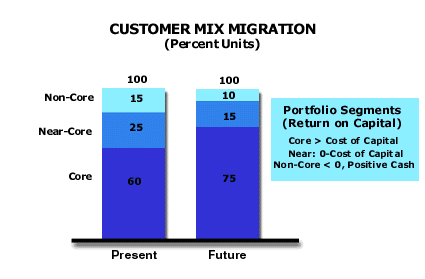Analysis 64: Customer Mix by Long Term Return of Customer Relationship
EXHIBITS:

| HOW TO INTERPRET THE ANALYSIS: This exhibit demonstrates today's and the future's mix of unit sales by the quality of the customer. There are three types of customer. Core customers allow the company to earn a Return on Investment of at least its Cost of Capital through the business cycle. Near-Core customers earn a Return on Investment that is positive but below the Cost of Capital. Non-Core customers earn a negative Return on Investment but do generate cash for the company with their purchases.
The company is improving its mix of customers over the planning horizon. Today, the company has 60% of its sales to Core customers, 25% to Near-Core customers and 15% to Non-Core customers. In the future, at the end of the planning period, the company anticipates having 75% of its sales to Core customers, 15% to Near-Core customers and only 10% to Non-Core customers. PURPOSE: This analysis divides the total volume of the business into Core, Near-core and Non-core customer volume. It conducts this estimate for both the present business and for the future business to estimate how the improvement in mix helps the Company reach the financial goal for the strategic planning period. APPROACH: One end point of the development of strategic plan, and the tactics that surround it, is to improve the company's mix of customers. The goal is a better mix of customers, a mix that will enable the company to earn its Cost of Capital, or more, over the business cycle. There are three types of customers in the Company's portfolio. The first customers are Core customers. They enable the company to make Return on Net Capital Employed (RONCE=EBIT divided by Net Capital Employed (total debt plus equity)) at or better than its Cost of Capital over the business cycle. The next set of customers are Near-core customers. They will earn the company a positive Return on Net Capital Employed (RONCE) over the business cycle, but not a rate equal to the Cost of Capital. These customers are worth carrying if the company can convert them into Core customers over some period of time. The final group of customers, the Non-core customers, earn positive cash whenever the company makes a sale to them. However, they do not earn a positive return on Net Capital Employed. They are customers with whom the company incurs losses on the relationship but a positive cash flow on sales. These customers do not cover their non-cash charges, such as depreciation. Over time, the company cannot afford to build capacity to serve them. As the company runs out of capacity to serve a market, it would gradually withdraw from these low-profit customer relationships. The rate of change in the customer mix in a slow growing market, with few new customers, is a function of Negative Volatility in the marketplace and the company's ability to capture that Volatility. As the company increases its share of competitors' Negative Volatility in the marketplace and selectively "edits" the least attractive customers, it arrives at a new customer mix with a better economic profile than the one with which it began the planning period. This analysis is most effective if the company develops check points on the accomplishment of specific goals on the way to the achievement of this improved customer mix. Elimination of Unattractive Customers Examples » Return to Diagnose Costs: Increasing Margins by Improving Customer Mix |
|
Recommended Reading |
| For a greater overall perspective on this subject, we recommend the following related items:
Analyses:
Symptoms and Implications: Symptoms developing in the market that would suggest the need for this analysis.
Perspectives: Conclusions we have reached as a result of our long-term study and observations.
|
